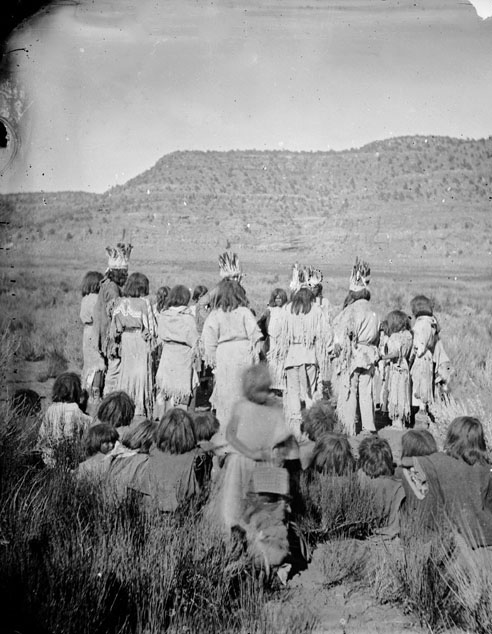Worldview
Integral to the world view of the Paiute was the concept of puha, or power. Puha could reside in any animate or inanimate object, and could be accessed by shamans or singers to bring about good. Shamans healed individuals who were ill or who were being plagued by ghosts. Singers—who, like the Mohave were given their songs during dream experiences—would sing songs to ensure a good hunt, to help the dead find their way to the afterworld, or simply to ensure the well being of an individual.
Not all powers were benevolent, however. Some spirits, such as water babies, were considered dangerous. Water babies are small supernatural beings that live in lakes, springs and rivers and that look for opportunities to drag people into the water to drown them. Water babies are believed to look somewhat like babies except that they have wings.
Paiute ceremonies included the social Round Dance, in which men and women linked arms and moved clockwise in a circle. In the 1890s, the Round Dance became a part of the religious Ghost Dance movement that originated with the Northern Paiute and soon swept through other tribes. This movement was initiated by a Paiute prophet named Wovoka, who prophesied that if Indians would live correctly and perform the Round Dance then their deceased ancestors would be resurrected, the white man would be vanquished from the continent, and the native landscape restored to its former condition. This message was readily accepted by the Southern Paiute, who by that time had been devastated by the impacts of Anglo colonization.
|
Paiute conducting a Round Dance, 1873. Source - http://sirismm.si.edu/naa/baegn/gn_01622.jpg |
In the mid to late 1800s the Southern Paiute adopted the mourning ceremony from the River Yumans. This ceremony, called the Cry Ceremony, was held within three months after someone had died. The ceremony would last five days and nights, during which times songs would be sung to honor the dead and to help them find their way to the afterlife. On the last day, valuables were burned in honor of the deceased. Because of the expense associated with hosting a Cry Ceremony, several families who had lost relatives might co-host a ceremony.
Finally, some Paiute adopted the Ute Bear Dance in the late 1800s from Plains Indian tribes. This ceremony is conducted in the spring when bears are waking up from their hibernation. The dance is conducted to pacify the bears and to give participants the power to escape from the bears. Its purpose was secular rather than religious, providing people with the opportunity to mingle with those of adjacent areas.
|
Source - http://en.wikipedia.org/wiki/File:Wovoka_Paiute_Shaman.jpg |
Wavoka, Paiute prophet who founded the Ghost Dance movement. Wovoka believed that if the Native Americans would perform the traditional round dances, their ancestors would drive the white colonists out of North America and restore peace and prosperity to the people.
|
Click on next page to continue.


